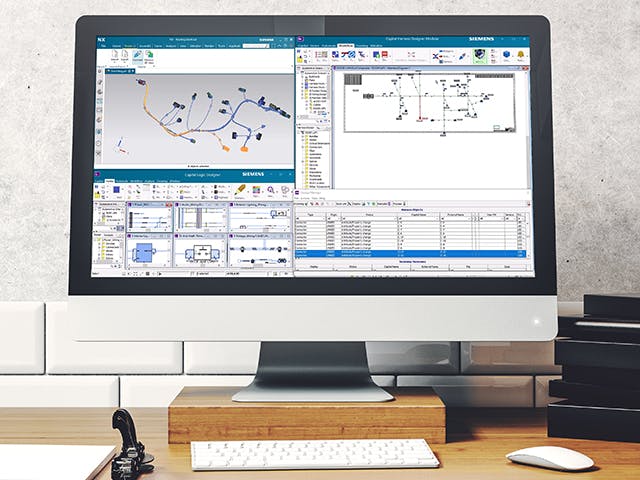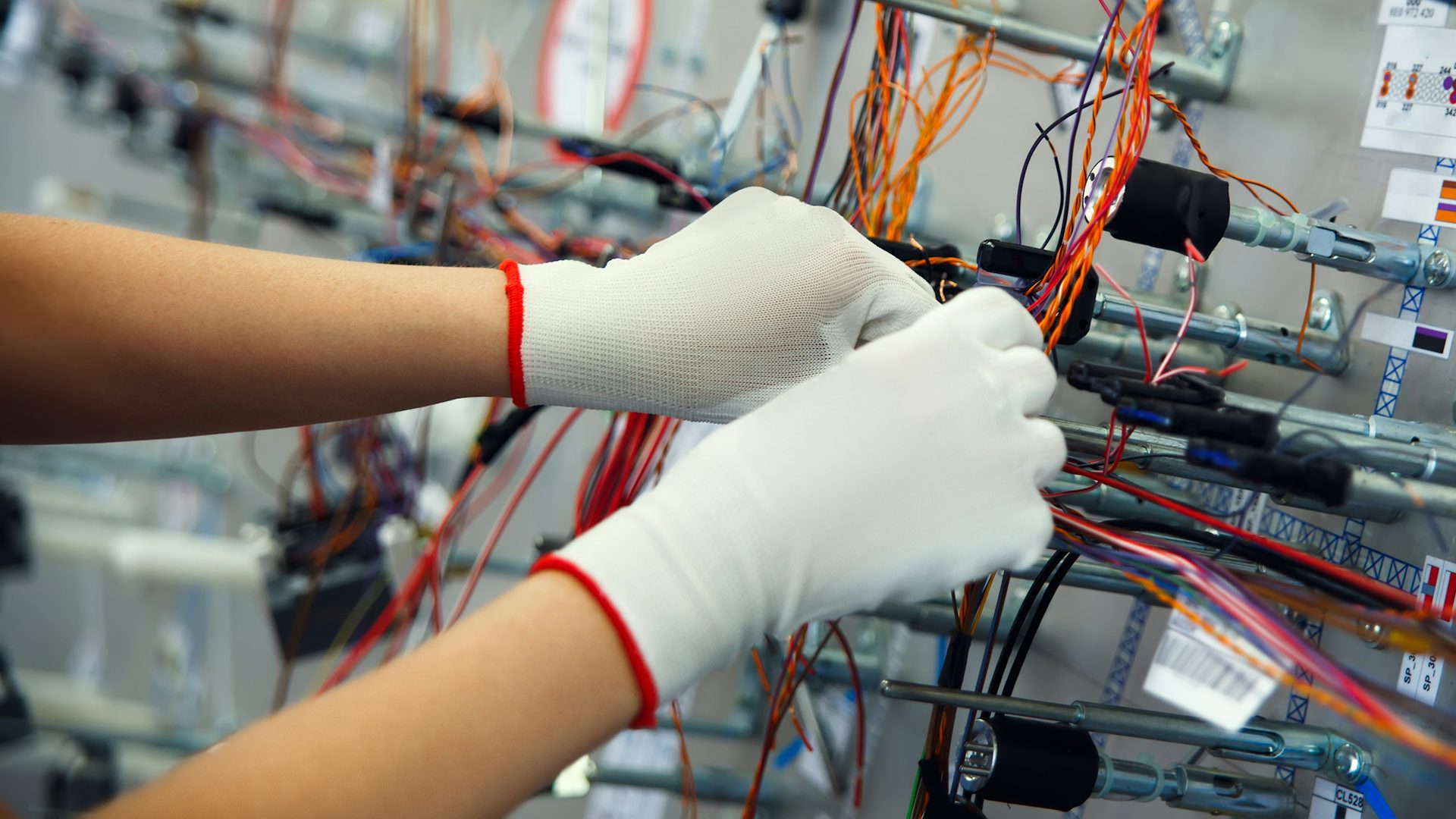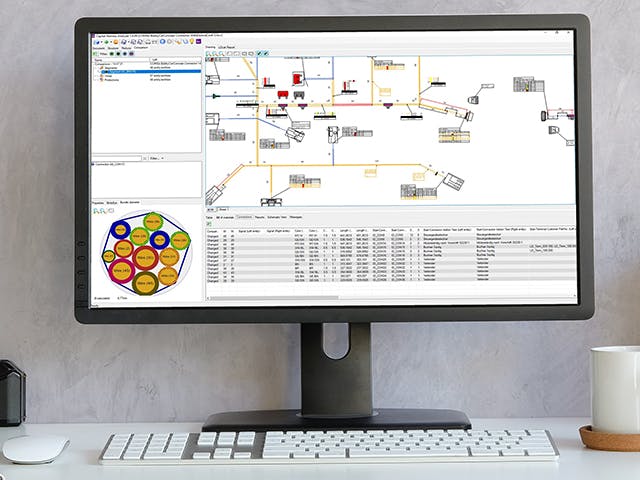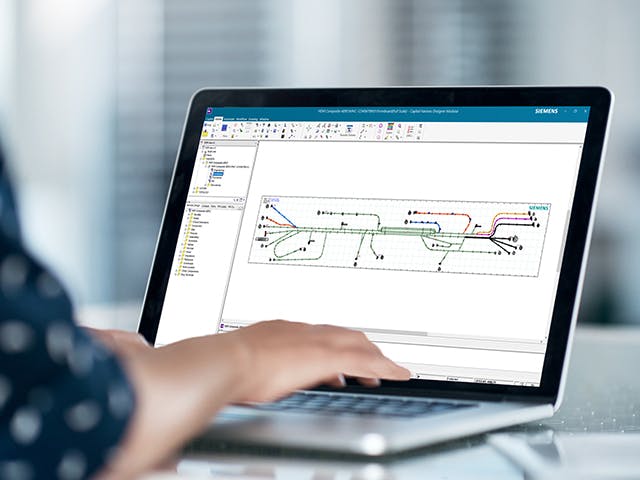
Projektowanie, optymalizacja i kalkulacja kosztów procesów wytwarzania
Projektowanie tablicy montażu okablowania
Dzięki rozwiązaniu Capital projektanci tablic montażu mogą stworzyć zoptymalizowany, ergonomiczny układ oparty na dynamicznych informacjach zwrotnych o nakładzie / czasie pracy związanej z każdym komponentem.
Planowanie procesu wytwarzania okablowania
Użyj rozwiązania Capital, aby przygotować i zastosować najlepsze praktyki do planowania procesu wytwarzania okablowania i zadań szacowania kosztów.
Dokumentacja wytwarzania okablowania
Jakość dokumentacji wytwarzania ma kluczowe znaczenie dla zminimalizowania błędów w kompilacjach. Twórz dokumentację wytwarzania bezpośrednio na podstawie danych z okablowania i zdefiniowanej sekwencji procesu montażu.
Wykorzystaj cyfrowego bliźniaka do zwiększenia wydajności
Wykorzystaj cyfrowego bliźniaka z rozwiązaniem Capital, aby zmienić sposób inżynierii, zoptymalizować koszty i wydajność produkcji swojej firmy. Wyeliminuj błędy w dokumentacji, zmniejszając koszty tworzenia, a w konsekwencji zwiększając zyski.
Optymalizacja procesów i poprawa wydajności wytwarzania
Bardzo szczegółowe i ulepszone projekty okablowania są często dokumentowane na rysunku 2D bez skalowania. Inżynierowie produkcji wykorzystują te informacje do tworzenia pełnowymiarowej reprezentacji danych projektu okablowania wzbogaconej o dodatkowe informacje produkcyjne, nazywane rysunkiem tablicy montażu.
Oprócz elementów okablowania wszystkie elementy istotne dla produkcji, takie jak widełki zestawów, uchwyty złączy, uchwyty zacisków i wskaźniki położenia taśmy, są graficznie odwzorowane na tych rysunkach z tablicy montażu, zapewniając operatorom pomoc wizualną. Wydajne środowisko graficzne i zarządzania projektowaniem do projektowania tablic montażu w oprogramowaniu Capital umożliwia inżynierom produkcji szybkie tworzenie pełnowymiarowych, szczegółowych i gotowych do produkcji schematów tablic montażu.
Rozwiązanie Capital ułatwia projektantom tablic montażu tworzenie zoptymalizowanego, ergonomicznego układu opartego na dynamicznych informacjach zwrotnych nakładu / czasu pracy związanych z każdym komponentem po umieszczeniu w określonej strefie na płycie. Projektanci mogą również tworzyć i zachować scalone lub połączone tablice w celu wydajnego wykorzystania linii produkcyjnych i miejsca w zakładzie produkcyjnym.
Tworzenie dokumentacji wytwarzania okablowania
Biorąc pod uwagę złożoność obecnego okablowania, ważna jest możliwość automatycznego tworzenia instrukcji dla operatora i ułatwienia wizualne dla każdego zakładu projektowego i produkcyjnego.
Jakość dokumentacji wytwarzania ma kluczowe znaczenie dla zminimalizowania błędów w kompilacjach. Twórz dokumentację bezpośrednio na podstawie danych dotyczących okablowania i zdefiniowanych sekwencji procesów montażu.
Usprawnij planowanie i optymalizację wytwarzania okablowania
Inżynierowie procesów produkcyjnych często stają przed wyzwaniem określenia wydajnego wzorca kolejnych etapów procesu, który zapewnia prawidłowy montaż docelowego okablowania. Zwykle istnieje więcej niż jeden możliwy wzorzec. Optymalny wybór zależy od konkretnych możliwości produkcyjnych danego zakładu. Rozwiązanie Capital ułatwia automatyczne tworzenie wydajnego schematu produkcji dla każdego wytwarzanego okablowania. Jest to możliwe dzięki dekompozycji projektów okablowania względem wcześniej utworzonych opisów możliwości produkcyjnych, przy użyciu aparatu analizy, który zawiera logikę montażu okablowania.
Inżynierowie mogą wykorzystać rozwiązanie Capital do rejestrowania i stosowania najlepszych praktyk w planowaniu procesów produkcyjnych i zadaniach kosztorysowania. Ułatwia szybkie i dokładne planowanie procesów, dając inżynierom więcej czasu na stworzenie wielu scenariuszy „co, jeśli”, które można porównać ze sobą i przeanalizować w celu uzyskania optymalnej wydajności produkcji. Inżynierowie produkcji mogą wykorzystać możliwości rozwiązania Capital do projektowania wydajnych linii produkcyjnych, efektywnego wykorzystania istniejących zasobów produkcyjnych i szybkiego reagowania na nowe sytuacje, takie jak zmiana wskaźników odbioru. Ułatwia to w podejmowaniu lepszych decyzji na hali produkcyjnej i ostatecznie skraca czas uzyskania rentowności.





